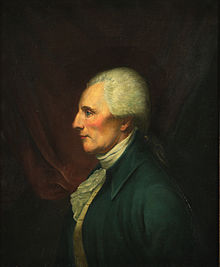Richard Henry Lee
| Richard Henry Lee | |
|---|---|

A painting of Lee at the National Portrait Gallery in Washington, D.C.
|
|
| 2nd President pro tempore of the United States Senate | |
|
In office April 18, 1792 – October 8, 1792 |
|
| Preceded by | John Langdon |
| Succeeded by | John Langdon |
|
United States Senator from Virginia |
|
|
In office March 4, 1789 – October 8, 1792 |
|
| Preceded by | Inaugural holder |
| Succeeded by | John Taylor |
| 12th President of the Confederation Congress | |
|
In office November 30, 1784 – November 4, 1785 |
|
| Preceded by | Thomas Mifflin |
| Succeeded by | John Hancock |
| Personal details | |
| Born |
January 20, 1732 Westmoreland County, Colony of Virginia, British America |
| Died | June 19, 1794 (aged 62) Westmoreland County, Virginia, U.S. |
| Resting place | Burnt House Fields, Lee Family Estate, Coles Point, Westmoreland County, Virginia |
| Political party | Anti-Administration |
| Spouse(s) | Anne Aylett (died 1768) Anne (Gaskins) Pinckard |
| Profession | Law |
| Religion | Episcopalian |
| Signature | |
Richard Henry Lee (January 20, 1732 – June 19, 1794) was an American statesman from Virginia best known for the motion in the Second Continental Congress calling for the colonies' independence from Great Britain. He was a signatory to the Articles of Confederation and his famous resolution of June 1776 led to the United States Declaration of Independence, which Lee signed. He also served a one-year term as the President of the Congress of the Confederation, and was a United States Senator from Virginia from 1789 to 1792, serving during part of that time as the second President pro tempore of the upper house.
He was a member of the Lee family, a historically influential family in Virginia politics.
He was born in Westmoreland County, Virginia to Col. Thomas Lee and Hannah Harrison Ludwell Lee on January 20, 1732. He was raised and came from a line of military officers, diplomats, and legislators. His father, Thomas Lee, was the governor of Virginia before his death in 1750. Lee spent most of his early life in Stratford, Virginia with his family at Stratford Hall. Here he was tutored and taught in a variety of skills, and witnessed the very beginning of political career as his father sent him around to neighboring planters with the intention for Lee to become associated with neighboring men of like prominence. In 1748, at 16, Lee left Virginia for Yorkshire, England, to complete his formal education at Queen Elizabeth Grammar School, Wakefield. Both of his parents died in 1750 and, in 1753, after touring Europe, he returned to Virginia to help his brothers settle the estate his parents had left behind.
...
Wikipedia
